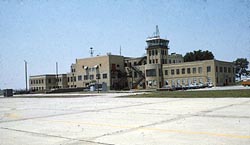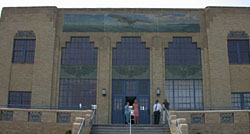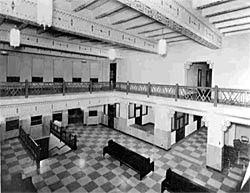
Construction of the Administrative Building at McConnell Air Force Base, originally Wichita's Municipal Airport terminal, began on June 28, 1930. On that date city officials and local aviation leaders participated in groundbreaking ceremonies designed to make Wichita, Kansas, a center of the aviation industry and a stopping place for passenger and airmail service. Wichita already had connections with aviation history; the Swallow Company began the first commercial aircraft manufacturing in Wichita from 1919 to 1920. By 1929 Wichita had 11 firms engaged in aircraft manufacturing plus a wide variety of support industries. By that time some 25 percent of the aircraft in use in the country were made in Wichita. To further their position in the aviation industry, it was necessary for Wichita to have an airport with refueling capabilities, maintenance hangars and administrative buildings to handle passengers, and 640 acres were purchased for this purpose by the city park board in 1928. By the spring of 1929 Wichita's Municipal Airport was well on its way to becoming a top grade airfield.

Because of financial difficulties during the Great Depression, the terminal building for the airport was not completed until 1935. Dedication ceremonies were held March 31, with an estimated crowd size of 10,000 to 15,000. Rain did not damper an abbreviated air show, and speeches were held to dedicate the building. Wichita's municipal airport was cited over and over again as an exemplary complex. Charles Lindbergh stated in 1929 during one of his visits to Wichita that there was no reason "why Wichita should not continue to be one of the most widely known of air centers." In 1936 Captain James B. Gordon, procurement planning representative of the material division of the U.S. Army Air Corps, called Wichita's airport the best in the country. During World War II the War Production Board used part of the facility. In December of 1944 Wichita's airplane factories were reported to have constructed 22,334 airplanes and 750 gliders. Designed by Glen J. Thomas of the Wichita firm of Harris and Thomas, the terminal building, consists of a central three-story portion built from 1930 to 1935 with flanking two-story wings built in 1942 and 1943. Typical of the Art Deco style are broad, flat wall surfaces broken by step-backs that emphasize doors, windows and the progression from one section of the building to another. Art Deco elements also include the stepped corners of windows, the inset stepped and faceted stones at the corners of the end bays and in the panels of stylized airplanes surrounded by chevron patterns. Some outstanding decorative features of the building surround the entrance; three large cast stone window spandrels in the three central bays that depict an eagle with spread wings superimposed over a stylized pattern of airplanes, and a large cast stone mural that runs the entire length of the three recessed bays. The three stone panels reflect both the nationalism of the 1930s and the stylization of Art Deco. The large panel was designed by L. W. Clapp, a prominent public figure in Wichita who was instrumental in bringing the aviation industry to the city. The color in the mural was obtained by crushing colored bottles in the cast stone mixture. The control tower is situated at the western end of the original building. Originally four stories tall, it had a glass-enclosed fifth story added in 1940.

The terminal building was managed by the city park department from the time of its construction until the municipal airport was sold to the Federal government in 1951. The base was known as Wichita Air Force Base until the name was changed to McConnell Air Force Base in honor of two Wichita brothers who were B-24 pilots in World War II. From 1951 to 1958 the facility was used primarily for testing SAC B-47 crews. The Boeing Aircraft Company had a lease on part of the building from 1956 to 1963 and used it for engineering, management and production of the B-52 aircraft. From 1963 to 1971 it was used by the Tactical Air Command for training F-105 crews. After that it served as the administrative center for personnel and transportation at McConnell. The control tower was used for training tower personnel. Today the Administrative Building houses the Kansas Aviation Museum, which documents the history of flight in Kansas from the earliest days to contemporary times and beyond.
Visit the National Park Service Travel American Aviation to learn more about Aviation related Historic Sites.
![]()
Last updated: September 3, 2017
